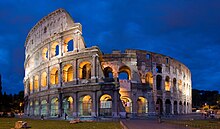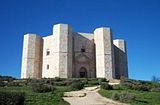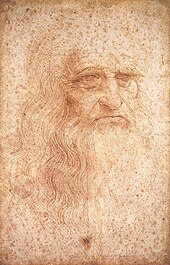Italy
Since ancient times, Greek, Etruscan, Celtic and other cultures have flourished in the territory of present-day Italy. Rome eventually emerged as the dominant power on the peninsula, conquering most of the "known world" as the leading political and religious centre of Western civilisation. During the Dark Ages, the Italian Peninsula faced calamitous invasions by barbarian tribes, but beginning around the 11th century, numerous Italian city-states rose to great prosperity through shipping, commerce and banking (indeed, modern capitalism has its roots in medieval Italy).[13] Especially during The Renaissance, Italian culture thrived, producing scholars, artists, and polymaths such as Leonardo da Vinci, Galileo, Michelangelo and Machiavelli. Italian explorers such as Polo, Columbus, Vespucci, and Verrazzano discovered new routes to the Far East and the New World, helping to usher in the European Age of Discovery. Nevertheless, Italy would remain fragmented into many warring states, subsequently falling prey to larger European powers such as France, Spain, and later Austria. Italy would thus enter a long period of decline that lasted until the mid 19th century.
After various unsuccessful attempts, the second and the third wars for Italian independence resulted in the unification of most of present-day Italy between 1859–66.[14] From the late 19th century to the early 20th century, the new Kingdom of Italy rapidly industrialised and acquired a colonial empire becoming a Great Power.[15][16] However, Southern and rural Italy remained largely excluded from industrialisation, fuelling a large and influential diaspora. Despite being one of the main victors in World War I, Italy entered a period of economic crisis and social turmoil, which favoured the establishment of a Fascist dictatorship in 1922. The subsequent participation in World War II at the Axis side ended in military defeat, economic destruction and civil war. In the years that followed, Italy abolished the monarchy, reinstated democracy, and enjoyed a prolonged economic boom, thus becoming one of the most developed nations.[5][17][18][19]
Italy has the third largest economy in the Eurozone (the eighth-largest in the world) and the highest life expectancy in the EU, due to a very high human development index.[20] Italy plays a prominent role in global military, cultural and diplomatic affairs[21] and is also considered to be a major regional power.[22][23][24] Italy is a founding and leading member of the European Union. The country is a member of numerous international institutions, including the UN, NATO, the OECD, the OSCE, the DAC, the WTO, the G6, G7, G8, G10, G20, the Union for the Mediterranean, the Latin Union, the Council of Europe, the Central European Initiative, the ASEM, the MEF and the Uniting for Consensus. Italy is home to the greatest number of World Heritage Sites (51).
History
Main article: History of Italy
Prehistory and antiquity
Main articles: Prehistoric Italy, Nuragic civilization, Etruscan civilization, Magna Graecia, Roman Italy, Ancient Rome, Roman Kingdom, Roman Republic and Roman Empire
The Colosseum in Rome, built c. 70 – 80 AD, is considered one of the greatest works of architecture and engineering.
Between the 17th and the 11th centuries BC Mycenaean Greeks established contacts with Italy[33][34][35][36] and in the 8th and 7th centuries BC Greek colonies were established all along the coast of Sicily and the southern part of the Italian Peninsula became known as Magna Graecia. Also the Phoenicians established colonies on the coasts of Sardinia and Sicily.
Rome, a settlement around a ford on the river Tiber conventionally founded in 753 BC, grew over the course of centuries into a massive empire, stretching from Britain to the borders of Persia, and engulfing the whole Mediterranean basin, in which Greek and Roman (and many other) cultures merged into a unique civilisation. The Roman legacy has deeply influenced the Western civilisation, shaping most of the modern world.[37] In a slow decline since the third century AD, the Empire split in two in 395 AD. The Western Empire, under the pressure of the barbarian invasions, eventually dissolved in 476 AD, when its last Emperor was deposed by the Germanic chief Odoacer, while the Eastern half of the Empire survived for another thousand years.
Middle Ages
Main article: Italy in the Middle Ages
The Iron Crown of Lombardy, for centuries symbol of the Kings of Italy.
Castel del Monte, built by German Emperor Frederick II.
It was during this chaotic era that Italy saw the rise of a peculiar institution, the medieval commune. Given the power vacuum caused by extreme territorial fragmentation and the struggle between the Empire and the Holy See, local communities sought autonomous ways to restore law and order.[40] In 1176 a league of city-states, the Lombard League, defeated the German emperor Frederick Barbarossa at the Battle of Legnano, thus ensuring effective independence for most of northern and central Italian cities. In coastal and southern areas, the maritime republics, the most notable being Venice, Genoa, Pisa and Amalfi, heavily involved in the Crusades, grew to eventually dominate the Mediterranean and monopolise trade routes to the Orient.[41]
In the south, Sicily had become an Islamic emirate in the 9th century, thriving until the Italo-Normans conquered it in the late 11th century together with most of the Lombard and Byzantine principalities of southern Italy.[42] Through a complex series of events, southern Italy developed as a unified kingdom, first under the House of Hohenstaufen, then under the Capetian House of Anjou and, from the 15th century, the House of Aragon. In Sardinia, the former Byzantine provinces became independent states known as Giudicati, although some parts of the island were under Genoese or Pisan control until the Aragonese conquered it in the 15th century. The Black Death pandemic of 1348 left its mark on Italy by killing perhaps one third of the population.[43][44] However, the recovery from the plague led to a resurgence of cities, trade and economy which allowed the bloom of Humanism and Renaissance, that later spread in Europe.
Early Modern
Leonardo da Vinci, the quintessential Renaissance man (self portrait, c. 1512).
The Renaissance, a period of vigorous revival of the arts and culture, originated in Italy thanks to a number of factors, as the great wealth accumulated by merchant cities, the patronage of its dominant families like the Medici of Florence,[46][47] and the migration of Greek scholars and texts to Italy following the Conquest of Constantinople at the hands of the Ottoman Turks.[48][49][50] The Italian Renaissance peaked in the mid-16th century as foreign invasions plunged the region into the turmoil of the Italian Wars. The ideas and ideals of the Renaissance soon spread into Northern Europe, France, England and much of Europe. In the meantime, the discovery of the Americas, the new routes to Asia discovered by the Portuguese and the rise of the Ottoman Empire, all factors which eroded the traditional Italian dominance in trade with the East, caused a long economic decline in the peninsula.
Following the Italian Wars (1494 to 1559), ignited by the rivalry between France and Spain, the city-states gradually lost their independence and came under foreign domination, first under Spain (1559 to 1713) and then Austria (1713 to 1796). In 1629–1631, a new outburst of plague claimed about 14% of Italy's population.[51] In addition, as the Spanish Empire started to decline in the 17th century, so did its possessions in Naples, Sicily, Sardinia, and Milan. In particular, Southern Italy was impoverished and cut off from the mainstream of events in Europe.[52] In the 18th century, as a result of the War of Spanish Succession, Austria replaced Spain as the dominant foreign power, while the House of Savoy emerged as a regional power expanding to Piedmont and Sardinia. In the same century, the two-century long decline was interrupted by the economic and state reforms pursued in several states by the ruling élites.[53] During the Napoleonic Wars, northern-central Italy was invaded and reorganised as a new Kingdom of Italy, a client state of the French Empire,[54] while the southern half of the peninsula was administered by Joachim Murat, Napoleon's brother-in-law, who was crowned as King of Naples. The 1814 Congress of Vienna restored the situation of the late 18th century, but the ideals of the French Revolution could not be eradicated, and soon re-surfaced during the political upheavals that characterised the first part of the 19th century.
Italian unification
Main articles: Italian unification and Military history of Italy during World War I
The legendary "handshake of Teano" between Giuseppe Garibaldi and Victor Emmanuel II: on 26 October 1860, the "Hero of Two Worlds" sacrificed republican hopes for the sake of Italian unity.
In 1860–61, general Giuseppe Garibaldi led the drive for unification in Naples and Sicily,[55] allowing the Sardinian government led by the Count of Cavour to declare a united Italian kingdom on 17 March 1861. In 1866, Victor Emmanuel II allied with Prussia during the Austro-Prussian War, waging the Third Italian War of Independence which allowed Italy to annexe Venetia. Finally, as France during the disastrous Franco-Prussian War of 1870 abandoned its garrisons in Rome, the Italians rushed to fill the power gap by taking over the Papal States.
The Piedmontese Albertine Statute of 1848, extended to the whole Kingdom of Italy in 1861, provided for basic freedoms, but electoral laws excluded the non-propertied and uneducated classes from voting. The government of the new kingdom took place in a framework of parliamentary constitutional monarchy dominated by liberal forces. In 1913, male universal suffrage was adopted. As Northern Italy quickly industrialised, the South and rural areas of North remained underdeveloped and overpopulated, forcing millions of people to migrate abroad, while the Italian Socialist Party constantly increased in strength, challenging the traditional liberal and conservative establishment. Starting from the last two decades of the 19th century, Italy developed into a colonial power by forcing Somalia, Eritrea and later Libya and the Dodecanese under its rule.[56]
The military cemetery of Redipuglia, resting place of approximately 100,000 Italian soldiers. More than 650,000 died on the battlefields of World War I.
During the war, more than 650,000 Italian soldiers and as many civilians died[60] and the kingdom went on the brink of bankruptcy. Under the Peace Treaties of Saint-Germain, Rapallo and Rome, Italy obtained most of the promised territories, but not Dalmatia (except Zara), allowing nationalists to define the victory as "mutilated". Moreover, Italy annexed the Hungarian harbour of Fiume, that was not part of territories promised at London but had been occupied after the end of the war by Gabriele D'Annunzio.








No comments:
Post a Comment